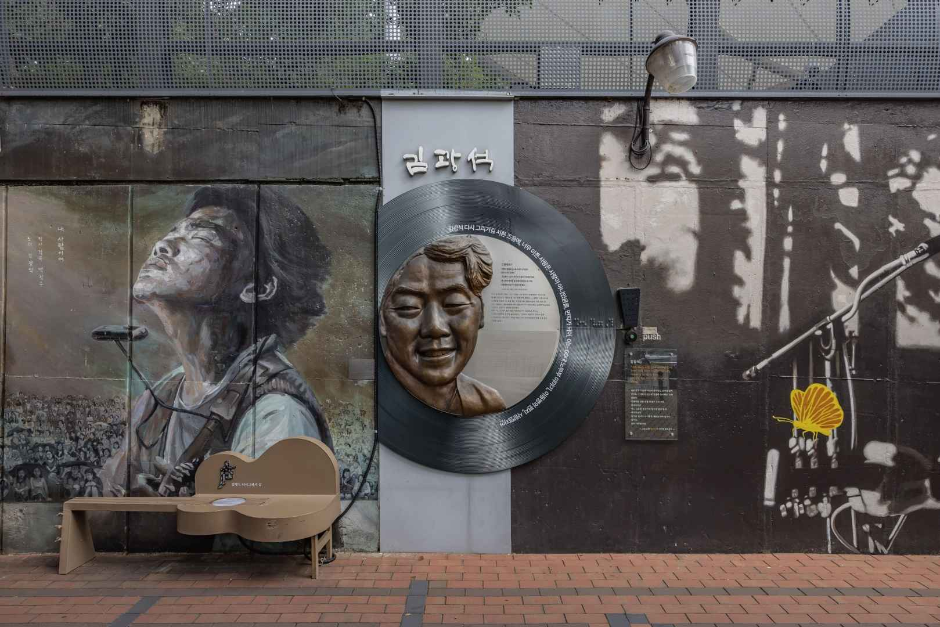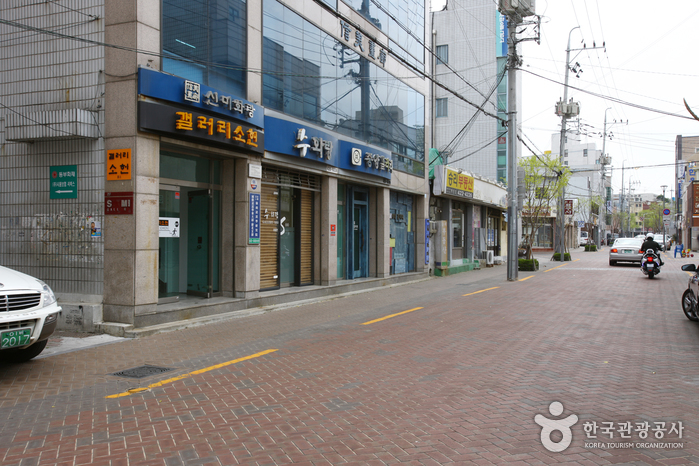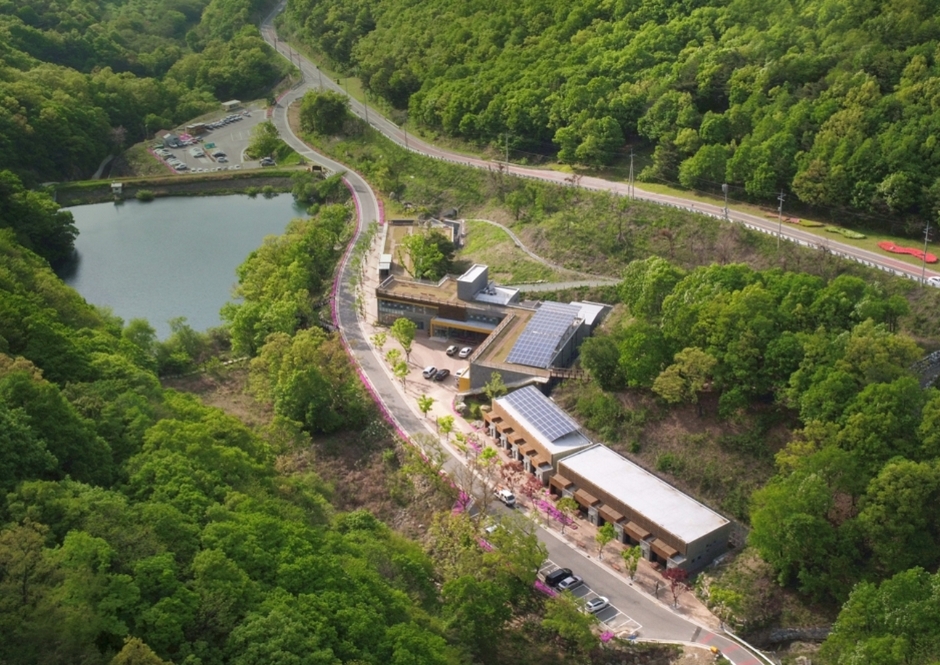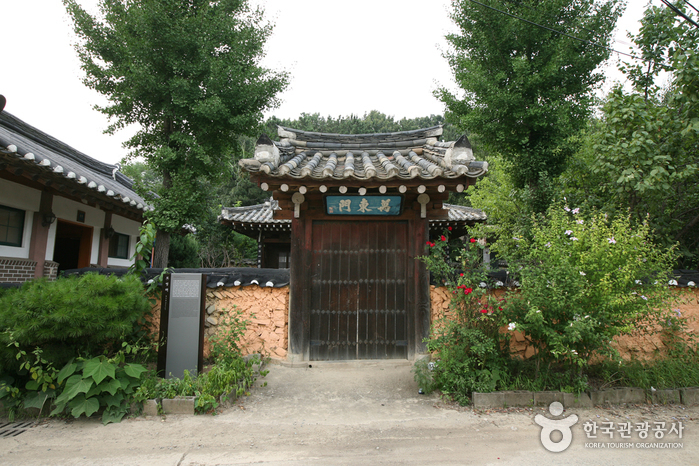Gugongtan Makchang (구공탄막창 본점)
16.2Km 2023-11-13
308 Gukchaebosang-ro, Seo-gu, Daegu
Gugongtan Makchang is famous in the area for their chewy tripe, served pre-grilled and ready to cook. The tripe plumps up and gets tender after cooking over the fire and goes great as is or dipped in sauce and eaten with a leaf wrap. The mushroom doenjangjjigae is also something not to be missed.
Kim Kwangseok-gil Street (김광석 길 (김광석다시그리기길))
16.3Km 2024-11-27
2238, Dalgubeol-daero, Jung-gu, Daegu
+82-53-218-1053
Kim Kwangseok-gil Street is a mural street near Bangcheon Market in the neighborhood where musician Kim Kwang-seok used to live prior to his passing. The 350 meter-long wall has statues and murals depicting his life and music. Every autumn, the area of Bangcheon Market and Dongseongno hosts a “Kim Kwang-seok Singing Contest” in his memory.
◎ Travel information to meet Hallyu’s charm - TV series"Hyde Jekyll, Me"
The place where Robin and Ha-na go on a last date together is Kim Kwangseok-gil Street, a series of alleyways next to Bangcheon Market adorned with murals dedicated to the legendary singer Kim Kwang-Seok. It also features many famous cafés and restaurants, so it is a popular date spot.
Bongsan Cultural Center (봉산문화회관)
16.3Km 2022-12-26
77, Bongsanmunhwa-gil, Jung-gu, Daegu
+82-53-661-3500
Bongsan Cultural Center is a comprehensive culture and arts complex located on Bongsan Culture Street in downtown Daegu. The center serves to provide cultural entertainment to the community as well as contribute to the development of traditional culture and local art. The center also provides opportunities for the public to participate in well-being recreational activities and acquire life-long education related to culture and arts.
The center has five modern exhibition halls (Exhibition Hall
No. 1-4 and Art Space) and two performance halls (Gaon Hall with 442 seats and Space Raon with 90 seats). As the center is located near Banwoldang Station (Daegu Subway Line 1), it is easily accessible by public transportation.
Olive Young - Daegu Beomeo Branch [Tax Refund Shop] (올리브영 대구범어)
16.3Km 2024-04-17
2379, Dalgubeol-daero, Suseong-gu, Daegu
-
Olive Young - Daegu Suseong 4(sa)-ga Branch [Tax Refund Shop] (올리브영 대구수성4가)
16.4Km 2024-04-18
1F, 2297, Dalgubeol-daero, Suseong-gu, Daegu
-
Bongsan Culture Street (봉산문화거리)
16.4Km 2025-01-09
38, Bongsanmunhwa-gil, Jung-gu, Daegu
+82-53-425-6845
Bongsan Culture Street is a landmark culture & arts place in Daegu. The street, which stretches all the way from Daegu Hakwon to Bongsan Yukgeori (six-way intersection), has over 20 galleries of various sizes.
It was 1991 when the small alley with several art galleries started to turn into a breeding ground for culture and the arts. Soon after, the street was officially designated ‘Bongsan Culture Street’ and subsequently, the roads were neatly paved, artistic street lamps were installed, and streetside gardens were created. With the opening of Bongsan Culture Center and Cultural House for Teens, the street became increasingly frequently by citizens, not just professional artists.
At Bongsan Culture Street, artwork os on display throughout the year and every October (when the Bongsan Art Festival is held) the whole street is filled with artistic passion.
Olive Young - Suseong-gu Office Station Branch [Tax Refund Shop] (올리브영 수성구청역)
16.4Km 2024-04-18
2518, Dalgubeol-daero, Suseong-gu, Daegu
-
National Center for Forest Activities, Chilgok (국립칠곡숲체원)
16.4Km 2025-09-03
532 Yuhak-ro, Seokjeok-eup, Chilgok-gun, Gyeongsangbuk-do
+82-54-977-8773
Sitting at the foot of Yuhaksan Mountain (839 meters above sea level) in Seokjeok-myeon, Chilgok-gun, Gyeongsangbuk-do, the National Center for Forest Activities, Chilgok is a national forest education center run by the Korea Forest Welfare Institute. Danuri Trail, created along the reservoir, is a barrier-free boardwalk trail designed to accommodate everyone, including the disabled. So anyone can enjoy the forest. It takes approx. two hours on any trail, including the Danuri Trail. The center runs forest education programs targeting various age groups, including children and the elderly. Families with kids can have a joyful time at the Tori Toddler Forest Experience Center. There are also various other facilities, such as the VR Experience Hall, Tori Kids Cafe, Book Cafe, and accommodations.
Korea Medical Institute Daegu Branch ((재)한국의학연구소 대구분사무소)
16.5Km 2025-07-29
B1-B2, 20 Jungang-daero 66-gil, Jung-gu, Daegu
Korea Medical Institute (KMI), a leader in 'K-health checkups,' operates health checkup centers across eight locations nationwide, from Seoul to Jeju. KMI has been striving to prevent and detect diseases early. It has led the popularization of comprehensive medical examinations in Korea. Based on 43 years of accumulated data and expertise, KMI has enhanced its capabilities in health checkups, services, and brand value.
By utilizing its diagnostic data accumulated over the years, KMI provides accurate test results and follow-up care promptly.
KMI will stay committed to becoming a lifetime health management partner and 'K-health checkup' leader by leveraging its excellence in Korean medicine, beyond health checkups for foreign patients.
Korean Traditional Culture Center (한국전통문화체험관)
16.5Km 2025-09-10
13-5 Dalgubeol-daero 527-gil, Suseong-gu, Daegu
+82-53-666-4930
Momyeongjae is an ancestral shrine built by the Dureung Doo clan to honor Doo Sa-chung, who had joined the Ming Dynasty's reinforcement troops during the Imjinwaeran (Japanese invasion of Korea, 1592) and later became naturalized in Joseon Dynasty. The name 'Momyeongjae' means 'longing for the Ming Dynasty,' expressing Doo Sa-chung's affection for his home country.
Doo Sa-chung, who was from Duling, China, went to Joseon under the command of General Li Rusong from the Ming Dynasty. Doo Sa-chung took the position titled Suryuk Jihoek Jusa and was responsible for selecting locations to establish a stronghold in consideration of the terrain. As a senior adviser to Li Rusong, he closely discussed strategies and tactics with the Joseon army as well.
When the war was over, Doo Sa-chung returned to China but went to Joseon again during the Jeongyujaeran (Japanese invasion of Korea, 1597). He brought his two sons -- Doo San and Doo Il-geon -- along with his brother-in-law, Admiral Chen Lin. When the war was over, Doo Sa-chung and his two sons naturalized in Joseon. The government of Joseon granted him land, which is the current Gyeongsang Gamyeong Park area.
When the Gyeongsang Gamyeong (Gyeongsang provincial office) was relocated to this area, Doo Sa-chung offered his land to the government and moved to Gyesan-dong.
Longing for his wife and brothers he had left in China, he moved again to a village near Daedeoksan Mountain (then Choejeongsan Mountain) and named the area Daemyeong-dong (meaning the Great Ming). He built a platform and on the first day of every month, he would bow in the direction of the Forbidden City in China, where the Emperor of the Ming Dynasty resided.
Momyeongjae is built on a rectangular plot and faces south. It features a hip-and-gable roof with double-layer eaves and has four rooms in the front and two rooms on the side. The daecheongmaru (wooden floor hall) has two ondol (floor heated) rooms on each of its side, with a half-sized bay at the front. Momyeongjae exemplifies the early 20th-century ancestral shrine style commonly found in the Daegu area.
The building was originally constructed in 1912 when Doo Sa-chung’s descendants moved wooden materials from the dismantled Gyeongsangaeksa (local government building) and used them to build Momyeongjae in front of Doo Sa-chung's tomb. The shrine was later renovated in 1966 as it was in poor condition.
Momyeongjae is one of the first destinations visited by Chinese tourists in Daegu. It was recently renovated as part of a redevelopment project. The Korean Traditional Culture Center opened nearby, where visitors can experience tea ceremonies, hanbok (traditional Korean clothing), archery, and cooking dishes based on Donguibogam, a traditional Korean medical encyclopedia. Joining a program at the center will be a valuable experience.


![Olive Young - Daegu Beomeo Branch [Tax Refund Shop] (올리브영 대구범어)](http://tong.visitkorea.or.kr/cms/resource/32/2884132_image2_1.jpg)
![Olive Young - Daegu Suseong 4(sa)-ga Branch [Tax Refund Shop] (올리브영 대구수성4가)](http://tong.visitkorea.or.kr/cms/resource/29/2884129_image2_1.jpg)

![Olive Young - Suseong-gu Office Station Branch [Tax Refund Shop] (올리브영 수성구청역)](http://tong.visitkorea.or.kr/cms/resource/42/2884142_image2_1.jpg)


 English
English
 한국어
한국어 日本語
日本語 中文(简体)
中文(简体) Deutsch
Deutsch Français
Français Español
Español Русский
Русский